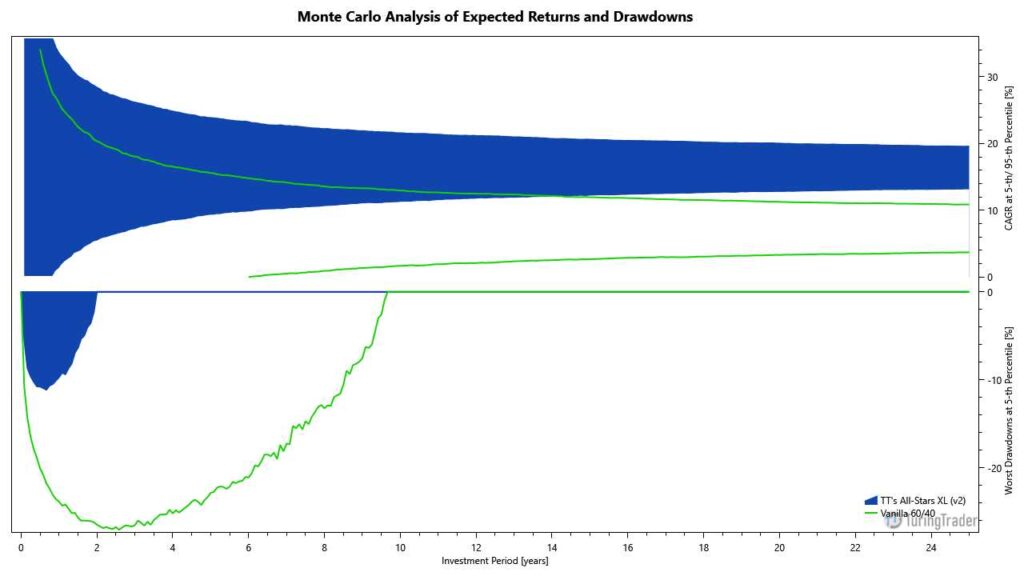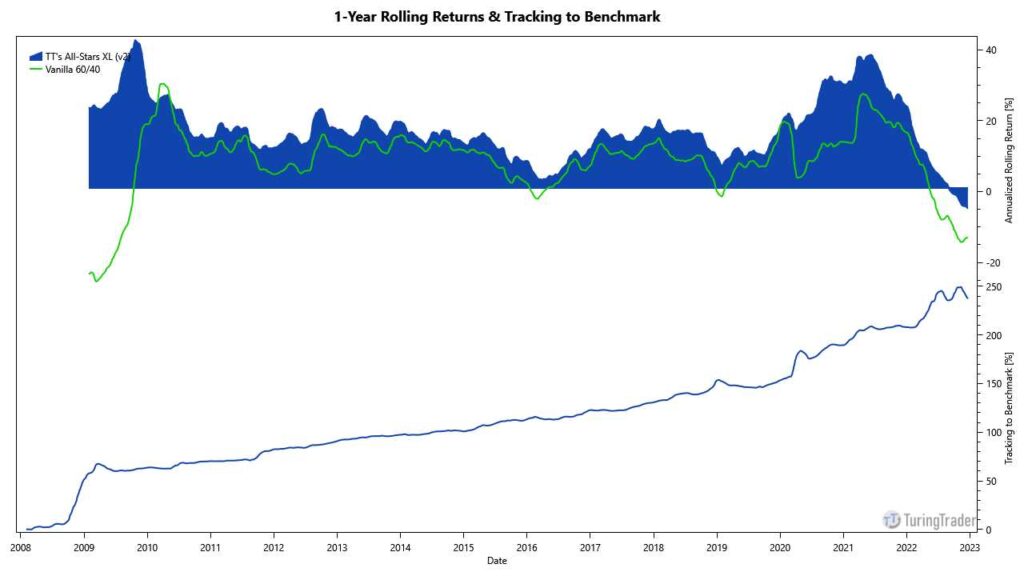Summary
- Objective: balanced growth
- Type: strategic portfolio
- Invests in: ETFs tracking stocks, bonds, cash, gold
- Rebalancing schedule: buy & hold
- Taxation: 20% short-term capital gains
- Minimum account size: $5,000
Harry Browne was a writer, politician, and investment adviser. He described the Permanent Portfolio in his book Fail-Safe Investing, which he published in 1999.
The Permanent Portfolio is a diversified passive portfolio that assures safety through the contrasting qualities of the four assets held.
Thanks to its passive nature, the Permanent Portfolio has only minimal maintenance requirements.
Performance
This table shows the portfolio’s key performance metrics over the course of the simulation:
The following chart shows the portfolio’s historical performance and drawdowns, compared to their benchmark, throughout the simulation:
This chart shows the portfolio’s annual returns:
The following charts show the Monte-Carlo simulation of returns and drawdowns, the portfolios 12-months rolling returns, and how the portfolio is tracking to its benchmark:


Asset Allocation
The portfolio last required rebalancing after the exchanges closed on @last-rebal@. Due to fluctuations in asset prices, the exact allocations vary daily, even when no rebalancing occurred. The current asset allocation is as follows:
Sign up for our FREE Basic membership to see the asset allocation.
Sign up for our FREE 14-day trial to see the asset allocation.
Strategy Rules
According to Harry Browne, the Permanent Portfolio provides three key features: safety, stability, and simplicity. Regardless of its simplicity, the Permanent Portfolio should protect investors against all economic futures while also providing steady returns.
The Permanent Portfolio invests 25% in U.S. stocks in providing strong returns during times of prosperity. The portfolio holds 25% in long-term U.S. Treasuries, which do well during prosperity and deflation. 25% of the Browne‘s portfolio is in cash to hedge against periods of tight money or recession. The remaining 25% is invested in precious metals to protect during periods of inflation.
Diversification
With this asset allocation, the Permanent Portfolio is well diversified and does well in many economic environments. More importantly, the portfolio should be safe regardless of which surprises the future might hold.
Returns & Volatility
Since the end of the last economic cycle in early 2008, Harry Browne‘s portfolio has delivered moderate returns with low volatility. Through losing less during the 2008 recession, the overall portfolio returns over this last cycle were about on par with a passive 60/40, even though the Permanent Portfolio is trailing its passive cousin in many years. However, the Monte-Carlo simulation shows that the Permanent Portfolio bears substantially less risk.
It is noteworthy that the portfolio holds an unusually high percentage in cash and gold. For long periods, both asset classes may be a drag on portfolio performance. Further, gold prices are often very volatile, albeit with low correlation to the other asset classes.
Account & Tax Considerations
Due to its passive nature, the Permanent Portfolio is very tax-efficient. Except for a small percentage of assets affected by rebalancing, the portfolio holds the same ETFs throughout. Therefore, Harry Browne‘s portfolio triggers only very few taxable events for its capital gains.
An account size of $5,000 should be sufficient to hold the portfolio’s four ETFs.
